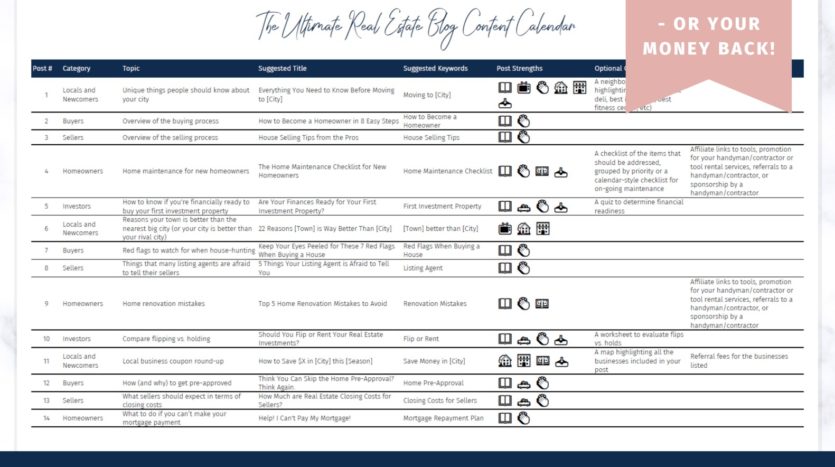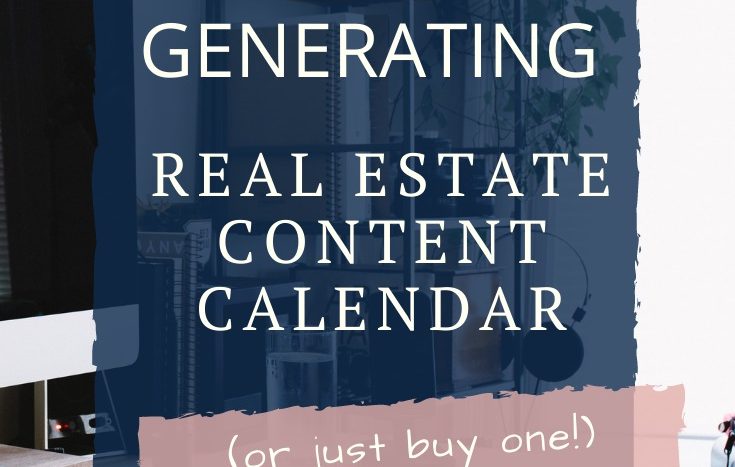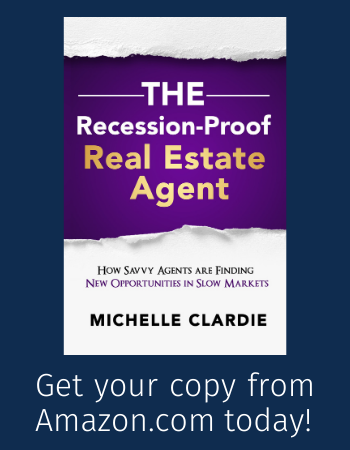Your real estate content calendar is more than just a list of topics for you to blog about. It’s a content strategy to help you generate new leads!
Think about this for a second:
Every time you publish a blog post, you’re giving Google more content to index. The more quality content Google indexes, the more likely Google is to recommend your site in their search results. And the more your site shows up in search results, the more buyers and sellers will find your site.
And what happens when buyers and sellers land find your blog post? They get to see how knowledgeable you are about your local market. They start to trust you before they ever even meet you. And since they trust you, they’re more likely to contact you!
So today we’re going to talk about how to craft a real estate content calendar that will rank on Google, bring in web traffic, and convert your web traffic to new leads!
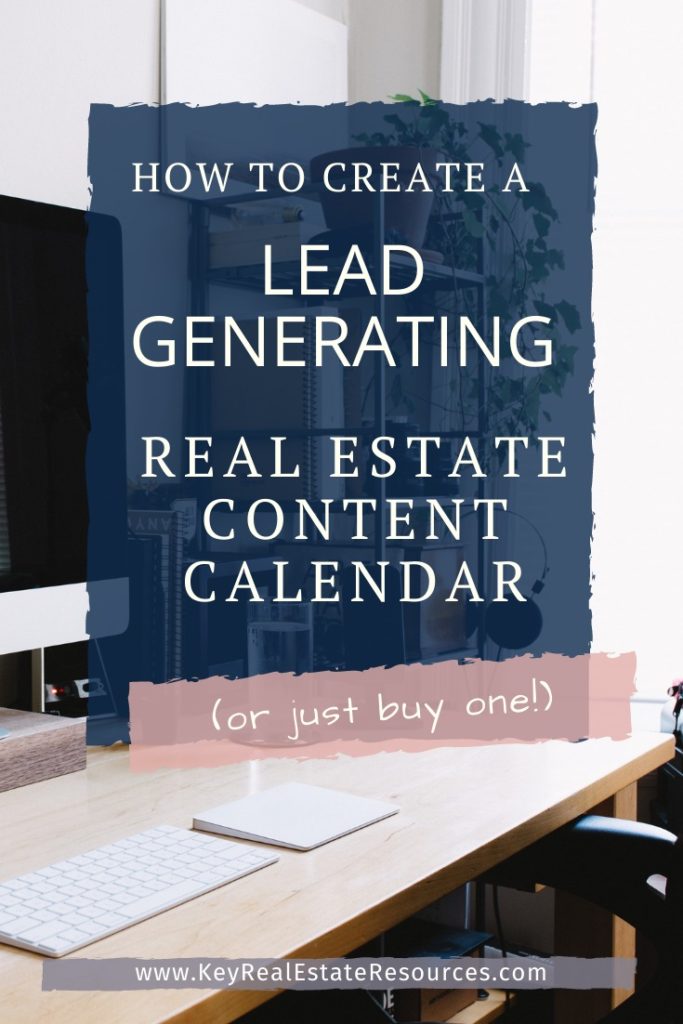
How to Create a Lead-Generating Real Estate Content Calendar
Here’s my 6-step process for creating a real estate content calendar, specifically designed to generate new leads.
Step 1: Decide on Your Real Estate Content Calendar Categories
Categories make it easier to focus your efforts and organize your blog posts. They also help your readers find the posts that are most relevant to them.
You don’t need many. Somewhere between 4 and 10 is good.
For most agents, the following 5 categories work perfectly:
- Buyers
- Sellers
- Homeowners
- Locals and Newcomers
- Investors
With this list, we’re hitting 5 categories of potential clients. You might just want to make a few changes if you’re highly specialized. For example, a Renters category might work for you if you specialize in property management or in first-time home-buyers.
Step 2: Brainstorm Topics for Your Real Estate Content Calendar
I like to open an Excel Sheet or Google Sheet and list every topic I can think of in 10 minutes. Set a timer to keep yourself focused and prevent this from becoming an hour-long task. You can always add to it later, but for now, you just need to get your ideas documented in one place.
How many ideas do you need?
I recommend agents commit to one blog post per week, so you need 52 ideas to round out your full year of real estate blog ideas.
Your priority should be to educate your audience. Ask yourself what do my future buyers want to know? What do my future sellers want to know? etc.
Warning: don’t make this mistake…
At this stage, most agents make the mistake of ignoring topics that have already been done. I have news for you: all topics have already been done. You don’t need to come up with a completely original topic. You’ll put your own unique spin on each topic when you actually start writing your posts.
So feel free to do a “first-time buyer’s guide to house hunting”, a “10 tips to stage your home for a quick sale”, and a “top 5 renovations to add value to your home”. Then when you sit down to write your post, focus on your local market for an instant unique spin. What do first-time buyers need to know about house-hunting in your city (in addition to all the nation-wide basics)?
You can also use the calendar to spin your topics. What should your local sellers know about staging their house to sell during the summer?
You can even spin economic conditions. How about DIY renovations that will add value without breaking your budget?
Popular blog post ideas are popular because people like them and find them useful. So don’t limit yourself to obscure topics.
Add to your list whenever a topic strikes your fancy
Whenever I come across an interesting post idea on social media or any of the (many!) Realtor blogs I follow, I take a second to add it to my ongoing list of real estate blog post ideas. By the time the next year rolls around, I typically have over 52 post ideas queued up and ready to be calendared.
Step 3: Schedule the Topics on Your Real Estate Content Calendar
Armed with your blog post ideas, it’s time to plug them into your Real Estate Blog Content Calendar.
Here’s the process I use to schedule my real estate blog ideas:
1. Stagger categories
You don’t want to spend months posting topics for buyers and ignoring everyone else. Staggering your categories makes sure you’re consistently providing information valuable to each group.

2. Fill in any time-sensitive posts.
Obviously, you want to publish posts about winter when your readers are preparing for the winter. If you have post ideas relating to certain holidays, calendar them for the weeks leading up to that holiday.
But use time-sensitive posts sparingly. You can’t promote these posts year-round, so they aren’t as valuable to you as “evergreen” content that’s always relevant. You can promote your evergreen content on social media platforms year-round for years to come!
3. Fill in the rest.
Now you simply enter your topics wherever you think they fit best. Just try to keep your topics varied so you’re not posting about similar topics for multiple weeks in a row.
Also try to keep your personal schedule in mind. Schedule your easiest-to-write topics for weeks when you know you’ll be extra busy. And your harder-to-write topics for weeks when you think you might have a little more time to invest in your blog.
That’s it! Easy, right?!
Step 4: Choose Your Keywords for Each Post
Keywords are the cornerstone of SEO (search engine optimization). These are the words you want to rank for on Google. For example, if someone types “how to become a homeowner” into Google, you want them to find your post about the buying process overview. Each blog posts gets its own keywords.
Choosing keywords is tricky. You don’t want to choose words with high competition (like “real estate”) because your website will never be big enough to compete with sites like Zillow for those competitive keywords. But you also don’t want to pick obscure keywords that no one is searching for. You need to find the keywords that have a fair number of monthly searches, but low competition. That’s your sweet spot.
And how exactly do you do that? Check out our Intro to SEO to learn how to use Google Adwords to research keywords and strategically select the keywords that are most likely to boost your Google ranking.

Step 5: Craft a Clickable Title for Each Post
Crafting a title (also called a headline) for each blog post also requires a balance. You want to give people a reason to click on your blog post. And once they do, you want your post to deliver on the title.
Ideally, you want your keywords to show up in your title, but not if it makes the title awkward.
Lucky for all of us, there’s a free tool to help craft clickable titles. I always run my title ideas through the Headline Analyzer by CoSchedule. It scores your headline (aim to get over 70), and it provides helpful feedback to improve your headlines.
The Headline Analyzer might not be perfect, but it provides helpful guidance, especially when you’re just getting started and aren’t completely sure what will work best for your target demographic. I usually test between 3 and 8 titles per post.
Step 6: Look for Content Upgrade Opportunities
Content upgrades (also called lead magnets) are valuable freebies you give your readers in exchange for their email addresses. Your audience gets something truly valuable, and you get to grow your email list.
For example, if you’re writing a post about the buying process, a checklist might be helpful for your first-time buyers.
This should go without saying, but your email list should be used very carefully; if you spam your audience, they will unsubscribe so fast! Only email them if you have something valuable to offer them.
You’ll just need an email service provider (ESP) to collect the email addresses and automatically email your freebie to your new contact. Learn more by reading How to Build Your Real Estate Mailing List.
BONUS Step 7: Look for Income Opportunities
You certainly don’t have to make money from your real estate blog. After all, the primary purpose of your blog is to generate new leads. But since you’re blogging anyway, wouldn’t it be nice to make a little passive income on your blog?
Run through your real estate content calendar and ask yourself if there are any opportunities to make a little side income from affiliate links or sponsorships.
Want a Shortcut?
You’re busy. I understand! If you don’t have time for all this planning and strategizing, why not have it done for you?
I’ve created The Ultimate Real Estate Content Calendar, packed with a full year of lead-generating topics, keywords, and suggested titles. I even included content upgrade ideas and flagged income opportunities!
It’s a complete real estate content strategy in a single PDF! And it’s available on Etsy for a limited time.
Snag your copy and start generating leads today!
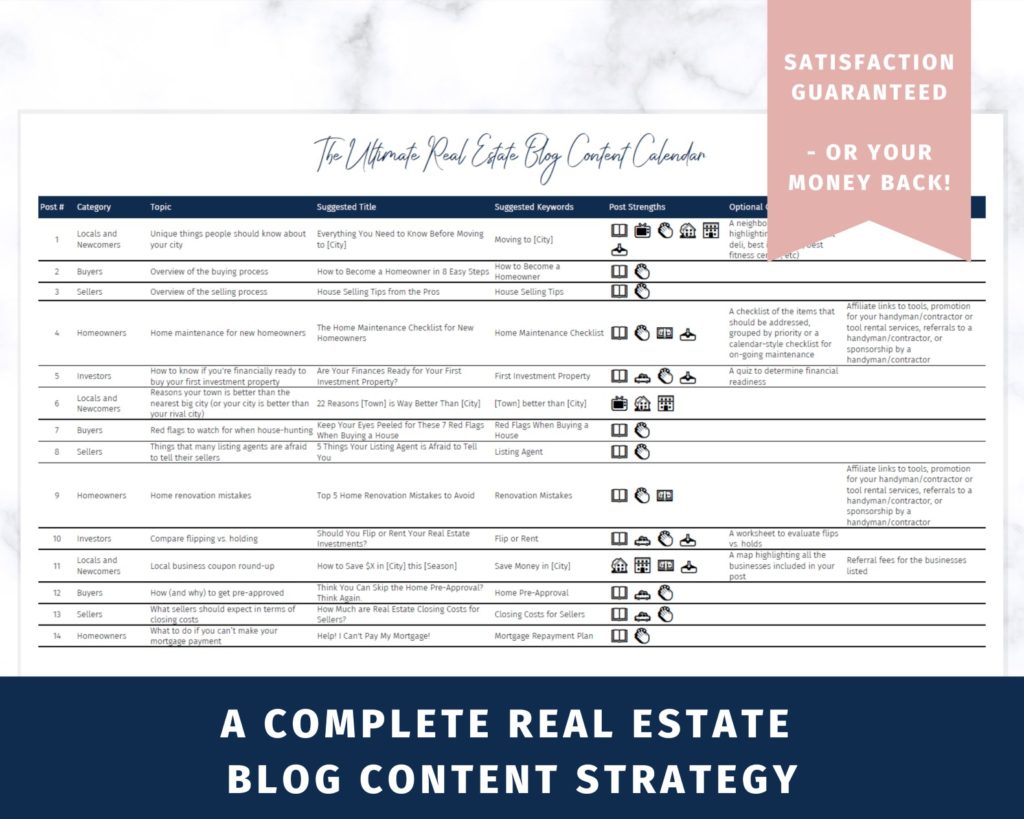
By the way, if you don’t already have a website of your own, it’s easier than ever to get one! Check out How to Build a Real Estate Website for completely free step-by-step instructions on building your own website. It’s easier than you might expect, and DYI-ing your site will save you thousands of dollars!


